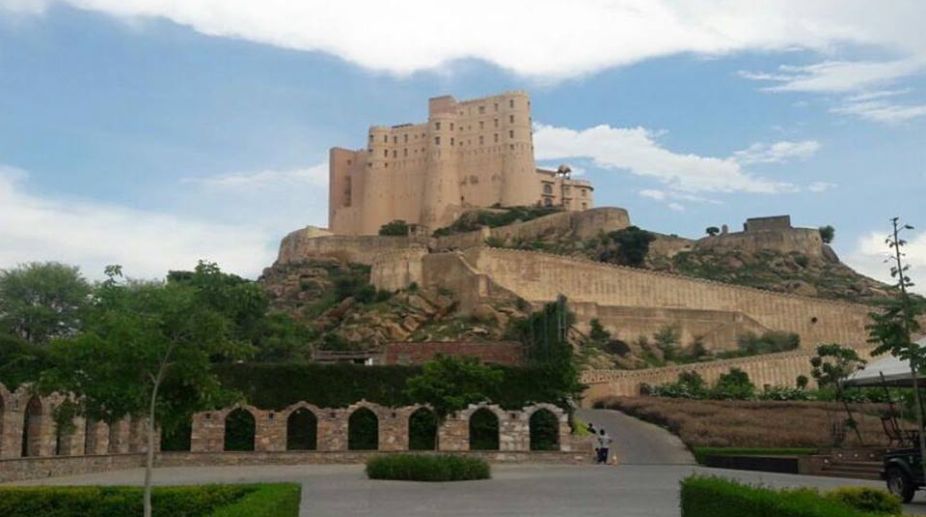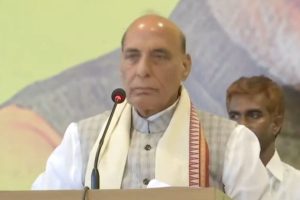We’ve all heard of ancient royal palaces being converted into luxury hotels. Rather, that’s the norm in a majority of such properties, especially if it flaunts the ‘heritage’ tag. So what if you were told about an old warrior fort, about 230 years old to be more specific, that was renovated and converted into a luxury hotel destination offering all amenities of a lavish stay right on the map of Rajasthan? I refer to the Alila Fort Bishangarh.
The grandeur is felt in its stark and inherent simplicity. The sheer walls of the imposing fort rise high above the hill in majestic splendour. Perhaps the only warrior fort that has been converted into a heritage resort, it is a unique example of the Jaipur Gharana architecture influenced by the Mughals.
The two-metre thick ancient walls around the fort have openings for firearms and turrets (burjs) which were used during times of battles to fight off enemy troops. A completely new structure has been added above and outside the old fort.
Advertisement
The hotel offers five different styles of royal suites. These comprise the Heritage, Royal, Grand, Regal, and Presidential, in ascending order of ‘luxury’, each suite has individual décor, shape, and even size due to the fact that the structure was a fort with curved walls and rooms, serving various needs. The Presidential Suite (highest category) is still under construction and is lavishness on an elevated scale. The original fort is left intact with much care given to its ecological restoration and construction of new residential areas, to recreate the signature flavour of Shahpura royalty.
The hotel has incorporated as much of its ancient form as possible. I was astonished to see giant rocks protruding in the corridors and open passages. The spa area originally housed the dungeons. From torture chambers they are now transformed into the abode of ultimate indulgence! The Alila Fort Bishangarh (‘Alila’ means surprise in Sanskrit) does full justice to its spectacular appearance. Accessible at a convenient distance from both cities, it is 180 kms (three hours) from Indira Gandhi International Airport, New Delhi while only 55 km (one hour) from Jaipur Airport.
The hotel’s primary draw is definitely its stunning form. In some places the walls are an incredible 2.5 meters thick and the renovation work took almost 10 years to complete. Stark and solid, the fort appears into view at the top of a hillock on the horizon as you approach by the winding path through the Bishangarh village.
Imposing and stately even in the distance, I watched it grow in size as the car drew up into the Haveli, the arrival courtyard. Reliving the history of Indian royalty, unlike other reception areas, Haveli is actually a majestic tent with rectangular pools of water along the sides that reflect the enormous fort up above on the hill while manicured greenery add tranquillity to a place already seeped in quiet elegance. I felt the warm welcome by their efficient hotel staff right from Jaipur airport where Rohit received me with a smiling face.
Host manager Sunaina Maneker was waiting at the Alila lobby to greet me on arrival and it didn’t take long to warm up to her endearing chit-chat. Chaitanya escorted me upstairs. My luggage was already in my enormous suite when I stepped inside.Talk of being spacious, I could easily have played badminton in there! The windows overlooked the rural countryside with small havelis, goats grazing and the Aravalli range rolling in the distance.
To retain the authentic appearance, decorations have been kept to a bare minimum. The walls and furnishings are in subdued hues while the wooden furniture fully incorporates the style of an earlier era. Somehow the subtle shades enhance the stately ambience even further. Alila showcases four ‘themed’ restaurants: Amarsar, the all-day dining area based on the Silk Route; Nazaara ~ an outdoor ‘roof top’ venue with spectacular views, Madhuveni, the bar & cigar lounge; and the open air Kachchawa Deck overlooking the sloping hillside of the fort and the Bishangarh village below. My three-day trip was filled with activities that enhanced the experience.
It was evening by the time I reached Alila on the first day and dinner that night was under an amazing night sky at Nazaara where the antique look of the fort was heightened by the soft glow of candles in wrought- iron lamps. Regional GM, Siddhart Savkur was host for the evening and ensured we were looked after with impeccable hospitality.
The high point was the food cooked in the sandpit that was delicious and tender. Breakfast next morning was in the open Kachchawa deck where I dug into scrumptious ‘palak puris’, a local delicacy made with millet and spinach, and washed it down with refreshing watermelon juice. I abstained from the typical ‘English breakfast’ of ham, eggs, etc. since that is passé and available everywhere. Sampling Bishargarh fare was infinitely more tempting. That day a spiritual journey was included where we visited the Kalka Mat Temple at Amarsar, (inspiring the name of the restaurant) situated at 500 meters above sea level. The journey took almost an hour.
The ancient stone idol is said to be over 4000 years old, drawing devotees from far and near. Monkeys loped about in complete abandon in the temple’s premises, but fortunately didn’t bother us at all. On returning, a ‘master class’ by Chef de Cuisine Rajat Chandna was held where he demonstrated a few dishes from their menus. The best part was eating what he had cooked there for our lunch.
When I asked about the dish he most enjoyed eating, he replied with disarming candour: “Khichdi!” Early evening was ‘spa time’ where my masseur, Dolly used Balinese techniques to knead my stressed-out limbs into perfect relaxation with the aid of divine lavender oil. We enjoyed cocktails accompanied by delightful sushi and kebabs at Madhuveni followed by a lavish dinner at Amarsar that night. The evening’s spa session ensured long restful sleep and I woke up fresh and raring to go for my final day’s excursions. First, we visited Kanha, a potter who demonstrated the art of making various shapes of tiny vases and even a piggy bank.
The interesting part was trying our hands at the potter’s wheel. Surprisingly, I managed to make a decent looking lamp (diya), but couldn’t bring it along since it has to be dried and painted, which takes at least a day. My flight back home was a few hours later that evening. We then drove to a carpet weaver’s home where the woman demonstrated her skills. Just a point to drive home about their hardy life: she was weaving woollen threads on the large loom at midday.
Imagine her plight in the peak of Rajasthan summer when the mercury hits 47 degrees Centigrade! We also stopped at a silver smith’s residence where he proudly displayed trinkets and jewellery for sale. We were then hosted by Daya at her homely ‘haveli’ for a typical farmer’s lunch of millet rotis, dal, garlic chutney and chanch (buttermilk). She made the rotis efficiently using her palms and cooked them on her rustic clay oven using firewood as fuel while we watched.
They were the most delicious rotis I’ve eaten, generously drizzled with homemade white butter! Himadri from Alila had accompanied us as our guide and looked completely at home in the ‘haveli’, chatting with Daya and her sister Sunita, and even served us while we sat on the floor mattress enjoying the homely ambience of Rajasthan’s Bishangarh village. I was told Daya is compensated by the hotel for this arrangement.
It was finally time to bid adieu to this ‘far-off’ land and I looked over my shoulder for one last time. Indeed, to stay at the Fort Alila Bishangarh resort in Rajasthan is a destination experience where one will seep in the history of the past while indulging in the luxury of living in the present.
Advertisement











